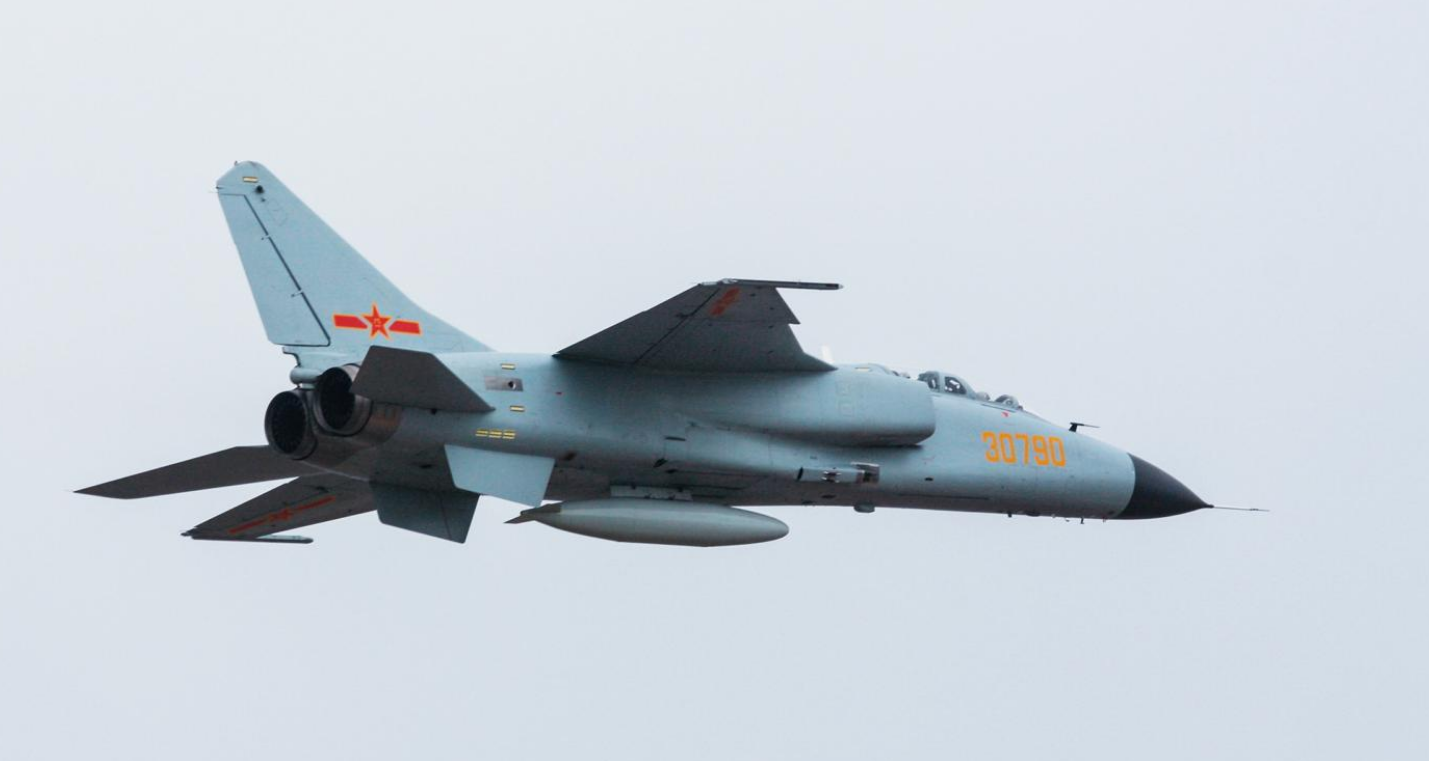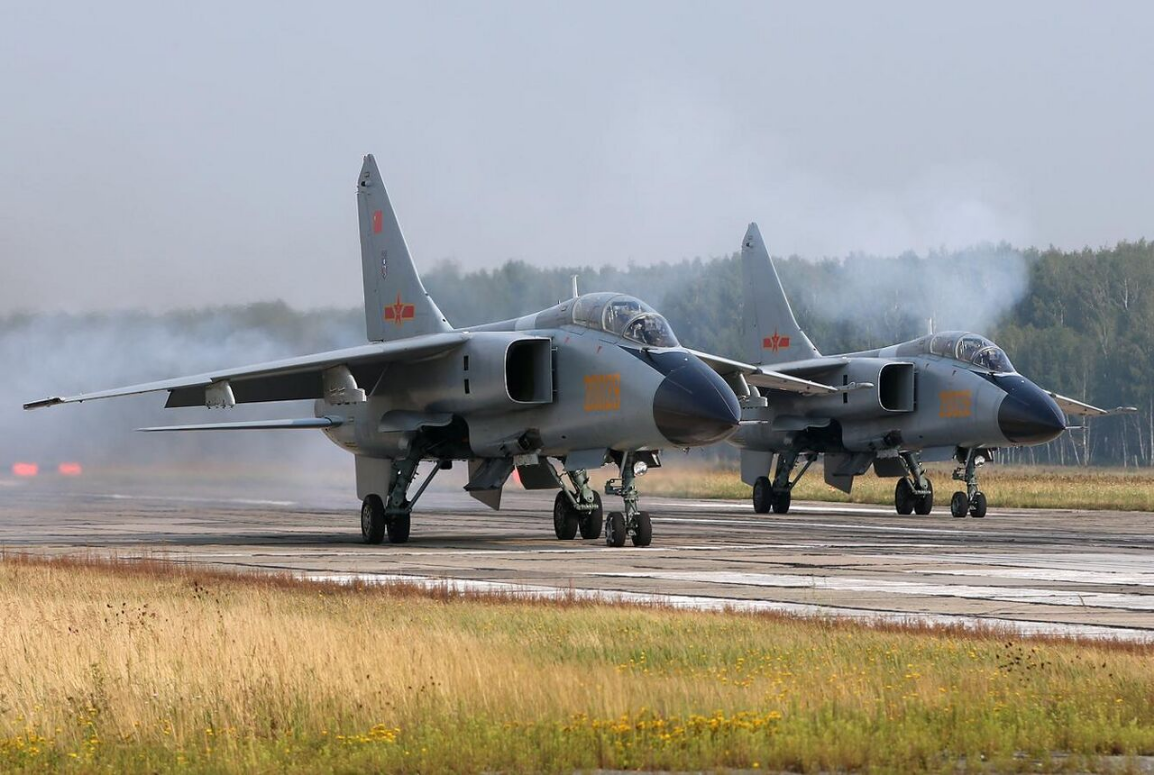
| Version | Summary | Created by | Modification | Content Size | Created at | Operation |
|---|---|---|---|---|---|---|
| 1 | Sirius Huang | -- | 1437 | 2022-11-18 01:37:18 |
Video Upload Options
The Xian JH-7 (Jianjiji Hongzhaji – fighter-bomber; NATO reporting name Flounder), also known as the FBC-1 (Fighter/Bomber China-1) Flying Leopard, is a tandem two-seat, twin-engine fighter-bomber in service with the People's Liberation Army Naval Air Force (PLANAF), and the People's Liberation Army Air Force (PLAAF). The main contractors are Xi'an Aircraft Industrial Corporation (XAC) and the 603rd Aircraft Design Institute (later named the First Aircraft Institute of AVIC-I). The first JH-7s were delivered to the PLANAF in the mid-1990s for evaluation, with the improved JH-7A entering service in 2004.
1. Development History
1.1. A New Fighter Bomber
In the early 1970s, the PLAAF required a new fighter-bomber to replace the Harbin H-5 and Nanchang Q-5. A request was duly submitted to the Ministry of Aviation Industry (later renamed to the Aviation Industry Corporation of China), which organized a domestic development program when efforts to secure a joint venture with foreign partners failed. The program was authorized on 19 April 1983 by then-paramount leader Deng Xiaoping. The program was also aiming to make use of newly imported British Rolls-Royce Spey turbofan engines at the time.[1]
1.2. JH-7

The PLANAF required a similar aircraft and the program set out to develop a variant for each set of requirements. The PLAAF variant would be a two-man all-weather deep strike bomber, with side-by-side cockpit seating, electronic countermeasures (ECM), and terrain following capabilities similar to the General Dynamics F-111. The PLANAF would receive a two-man all-weather, tandem cockpit, strike and reconnaissance aircraft. The PLAAF variant was dropped in the early 1980s, with the PLANAF variant becoming the JH-7.
Six prototypes were built by December 1988, and the PLANAF received 12 to 18 aircraft in the early 1990s for evaluation. The first aircraft used imported Rolls-Royce Spey Mk.202 engines, later replaced by a license-built copy, the WS-9. They were equipped with the Type 243H multifunction radar, which could detect ships at a maximum of 175 kilometres (109 mi), and MiG-21-sized aerial targets at 75 kilometres (47 mi).
The JH-7 was designed as an anti-shipping fighter-bomber. As with the later JH-7A, its aerial combat capability was insignificant given the large number of specialist aircraft for that role.
1.3. JH-7A


When the PLA examined the future role of air forces, it identified a need for precision air-to-surface capability. An improved JH-7, the JH-7A, was designed to meet this requirement. The JH-7A's general and deputy general designers were Tang Changhong (唐长红) and Wu Jieqin (吴介琴) respectively.
The JH-7A had a lighter and stronger airframe than the JH-7, allowing the newer aircraft to carry a maximum ordnance load of 9000 kg.[2][3] In PLANAF, this allowed four YJ-82 anti-ship missiles to be carried, compared to the two on the JH-7.[4]
The JH-7A is equipped with domestic Chinese helmet mounted sight (HMS) for evaluation, and this HMS currently being tested is developed by Xi'an Optronics Group (Xi Guang Ji Tuan 西光集团), a member of Northern Electro-Optic Co. Ltd (北方光电股份有限公司), the wholly owned subsidiary of Norinco, and the HMS on JH-7A was developed from the helicopter HMS manufactured by the same company, thus both share many common components.[5] HMS tested on JH-7A is compatible with air-to-air/surface missiles, and it is also compatible with airborne sensors such as radars and electro-optics so that the sensors are slaved to HMS, enabling the fast tracking and aiming of the weaponry.[6] The cockpit of JH-7A still retains some traditional single function dial indicators, but there are two large color liquid crystal display multi-function displays which can be monochrome if pilots choose.[7] Other avionic upgrades of JH-7 include:[8] replacing Type 960-2 noise jammer with BM/KJ-8605, replacing Type 265A radar altimeter with Type 271 radar altimeter, fully digitized fly-by-wire flight control system, and in addition, Type 232H airborne radar is replaced by JL-10A pulse Doppler radar, enabling JH-7A to fire laser-guided bombs and Kh-31P anti-radiation missiles. The existing JH-7s were upgraded with JH-7A electronics. Two additional hardpoints increased the total to 6 from the original 4, and one-piece windscreen replaced the original three-piece windscreen.
The JH-7A was the first Chinese aircraft to use paperless design, and the software used was CATIA V5.[9]
1.4. JH-7B
A new and much improved variant, the JH-7B, is currently under development. It features a whole new avionics system, a more powerful WS-9A engine, and new advanced weapons package including the YJ-12. The JH-7B also added aerial refueling capabilities, greatly increasing its combat radius. The JH-7B was also once believed to have reduced RCS for stealth, but recent pictures show no changes in the airframe.[10] The JH-7B was expected to enter production in 2015.
2. Operational History
On its maiden flight on 14 December 1988, while en route back to the airport to land, the engines of the JH-7 prototype suddenly begun to vibrate violently. The test pilot Huang Bingxin (黄炳新) decided to make an emergency landing, but as he approached the airport, the vibration was so great that two thirds of the instruments had been shaken off the instrument panel, and all of the connectors of the remaining third still attached to the panel had also been shaken loose, so none of the instruments worked; the pilot nonetheless managed to eventually land the prototype safely.[11]
On 8 June 1991, a JH-7 prototype suddenly began to leak fuel at a high rate. Lu Jun (卢军), a Russian trained Chinese test pilot, managed to make a safe emergency landing when the fuel reserve had dropped to slightly more than 30 liters. Three years later, on 4 April 1994, a JH-7 prototype crashed during a test flight, killing Lu.[11]
On 19 August 1992, the entire rudder of a JH-7 suddenly fell off at an altitude of 5000 meters, while carrying four live missiles. Against orders to jettison the missiles and abandon the aircraft, the test pilot decided to attempt an emergency landing. Using mainly differential thrust of the two engines, the test pilot Huang Bingxin (黄炳新) made it back to the airport and attempted to make an emergency landing, but a tire at the starboard side exploded on touch down, causing the aircraft to veer off course. Using brakes as control, the test pilot made two attempts before finally releasing the drogue parachute to finally stop safely.[11]
The JH-7A entered service with the PLANAF in early 2004, and with the PLAAF by the end of the year.[12]
In 2007 JH-7s went abroad to participate in "Peace Mission" exercises of the Shanghai Cooperation Organization (SCO). In April 2012, multiple JH-7 aircraft joined a Russia-China joint naval exercise in eastern China. In 2013, JH-7s participated in a Russia-China joint exercise held in Russian territory.[13]
3. Operators
- People's Republic of China
- People's Liberation Army Naval Air Force – 120 ((As of January 2014)).[14]
- People's Liberation Army Air Force – 120 ((As of January 2014)).[14][15]
4. Variants
- JH-7 – Initial production version of the PLANAF anti-shipping fighter-bomber.
- JH-7A – Later production utilising composite structure to reduce weight, improved flying control system and improved avionics including the JL10A Shan Ying J-band Pulse-Doppler radar. Weapon loads increased by the addition of two more wing hardpoints and two hardpoints under the intake trunking for mission pods such as targeting pods.
- JH-7B - New variant, with upgraded avionics, engines with 15% more thrust, in flight refueling, upgraded mission computer, full authority digital fly-by-wire system, and greater use of composite materials.
- FBC-1 Flying Leopard – Export version of the JH-7.
- FBC-1A Flying Leopard II – Export version of the JH-7A.
5. Specifications (JH-7)
Data from AVIC I, SinoDefence.com
General characteristics
- Crew: 2: pilot, weapons operator
- Payload: 9,000 kg[2][3] (19,842 lb) of weapons
- Length: 22.32 m (73 ft 2 in)
- Wingspan: 12.8 m (41 ft 7 in)
- Height: 6.22 m (20 ft 4 in)
- Wing area: 42.2m² (ft²)
- Empty weight: 14,500 kg[16] (31,900 lb)
- Loaded weight: kg (lb)
- Max. takeoff weight: 28,475 kg[17] (62,720 lb)
- Powerplant: 2 × Xian WS-9 afterburning turbofans
- Dry thrust: 54.29 kN (12,250 lbf) each
- Thrust with afterburner: 91.26 kN (20,515 lbf) each
Performance
- Maximum speed: Mach 1.75 (1,808 km/h, 1,122 mph)
- Combat radius: 1,760 km (950 nm, 1,100 mi with one in-flight refueling (estimated), 900 km without refueling (estimated))
- Ferry range: 3,700 km (1,970 nm, 2,299 mi)
- Service ceiling: 16,000 m (51,180 ft)
- Wing loading: kg/m² (lb/ft²)
Armament
- Guns: 1× 23mm twin-barrel GSh-23L autocannon, 300 rounds
- Hardpoints: 9 in total (6× under-wing, 2× wing-tip, 1× under-fuselage) with a capacity of 9,000 kg (20,000 lb) external fuel and ordnance
- Rockets: 57mm/90mm unguided rocket pods
- Missiles:
- Bombs:
- Unguided bombs
- Laser-guided bombs
- GB1
- GB5
- Satellite-guided bombs
- LS-6
- FT-12
- GB6
- FT-2
- FT-3
- FT-6
Avionics
JL-10A radar
References
- "JH7 FBC1 fighter bomber and Spey turbofan, Chinese PLAAF". AirForceWorld.com. http://airforceworld.com/pla/fbc-1-jh-7-fighter-bomber-china.htm. Retrieved 12 July 2011.
- "Fuel needs limit China's combat ability". upiasia.com. 28 December 2007. http://www.upiasia.com/Security/2007/12/28/fuel_needs_limit_chinas_combat_ability/6628/. Retrieved 2010-03-21.
- "Xian JH-7". Aeroflight.co.uk. http://www.aeroflight.co.uk/types/china/xian/jh-7/jh-7.htm. Retrieved 2010-03-21.
- "JH-7A for PLAAF". AirForceWorld.com. 25 March 2011. Archived from the original on 18 October 2010. https://web.archive.org/web/20101018224703/http://airforceworld.com/pla/fbc-1-jh-7-fighter-bomber-china-2.htm. Retrieved 2011-03-25.
- "中国展示最新型战机直升机头盔瞄准具![组图--军事频道-中华网-中国最大军事网站"]. http://military.china.com/zh_cn/important/11052771/20081113/15184593_3.html. Retrieved 4 February 2015.
- "中国展示最新型战机直升机头盔瞄准具![组图--军事频道-中华网-中国最大军事网站"]. http://military.china.com/zh_cn/important/11052771/20081113/15184593_1.html. Retrieved 4 February 2015.
- "严重官泄:歼轰-7A座舱--军事--中华网—网罗心中的华彩". http://military.china.com/zh_cn/bbs/11018441/20060715/13469762.html. Retrieved 4 February 2015.
- "JH-7 Avionics". http://www.docin.com/p-428438807.html. Retrieved 2011-11-17.
- "中华网论坛十周年--歼轰-7诞生记--网友影响中国--全国最大社区媒体". http://club.china.com/data/thread/25298684/272/13/10/0_1.html. Retrieved 4 February 2015.
- "Archived copy". Archived from the original on 30 December 2013. https://web.archive.org/web/20131230235735/http://news.gasshow.com/News_1407096.html. Retrieved 29 December 2013.
- "JH-7 Accidents". http://ido.3mt.com.cn/Article/200801/show877897c30p1.html. Retrieved 2008-01-03.
- "JH-7 History". Sinodefence.com. 24 October 2008. http://www.sinodefence.com/airforce/groundattack/jh7history.asp. Retrieved 2011-06-27.
- "JH7 / FBC1 Fighter Bomber". AirForceWorld. 22 Oct 2014. http://www.airforceworld.com/pla/english/jh-7-jh-7a-fbc-1-fighter-bomber-china.html. Retrieved 2014-10-23.
- Adam Baddeley (February 2011). "The AMR Regional Air Force Directory 2011". Asian Military Review. Archived from the original on 28 September 2011. https://web.archive.org/web/20110928163252/http://www.asianmilitaryreview.com/upload/201102172337151.pdf. Retrieved 11 July 2011.
- "Chinese fighter crashes at air show". BBC World News. 14 October 2011. https://www.bbc.co.uk/news/world-asia-pacific-15302692.
- CATIC brochure, Zhuhai 1998
- CATIC website, "Archived copy". Archived from the original on 31 August 2011. https://web.archive.org/web/20110831183108/http://www.catic.cn/indexPortal/home/index.do?cmd=goToChannel&cid=738&columnid=1906&cpid=1626&dataid=4240&columnType=102&likeType=view&ckw=FA. Retrieved 28 April 2012.
- "PL-5 Short-range Air-to-air Missile". Sinodefence.com. 9 April 2006. Archived from the original on 11 November 2012. https://web.archive.org/web/20121111174758/http://www.sinodefence.com/airforce/weapon/pl5.asp. Retrieved 2007-01-16.
- "YJ-8K (C-801K) Air-launched Anti-ship Missile". Sinodefence.com. 9 April 2006. Archived from the original on 30 December 2006. https://web.archive.org/web/20061230145601/http://sinodefence.com/airforce/weapon/yj8k.asp. Retrieved 2007-01-16.
- "YJ-82K (C-802K) Air-launched Anti-ship Missile". Sinodefence.com. 9 April 2006. Archived from the original on 30 December 2006. https://web.archive.org/web/20061230045412/http://sinodefence.com/airforce/weapon/yj82k.asp. Retrieved 2007-01-16.
- "JH-7A KD-88 Air-to-ground Missile". AirForceWorld.com. 25 March 2011. Archived from the original on 18 October 2010. https://web.archive.org/web/20101018224703/http://airforceworld.com/pla/fbc-1-jh-7-fighter-bomber-china-2.htm. Retrieved 2011-03-25.
- "KH-31P/YJ-91 Anit-radiation Missile". Sinodefence.com. 1 April 2006. Archived from the original on 30 December 2006. https://web.archive.org/web/20061230045259/http://sinodefence.com/airforce/weapon/kh31.asp. Retrieved 2007-01-16.




